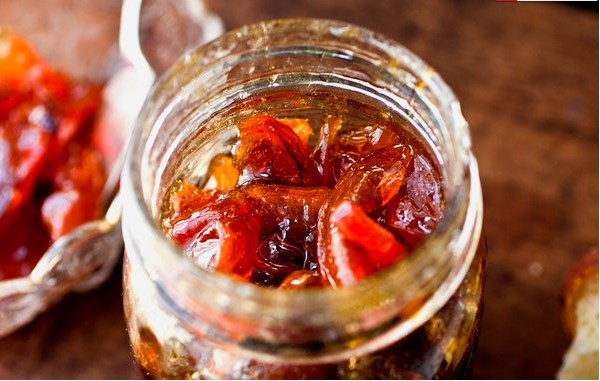Move the milk, make room for the jam
Updated: 2012-09-17 11:14
(Agencies)
|
|||||||||||
 |
|
Nectarine and peach jam with lemon verbena. [Photo/The New York Times] |
The canning part is why it took me years to make a batch of jam, what with all that equipment and the measures you take to sterilize it. What would happen if I did it wrong? Would I kill my whole family after one marmalade-slathered breakfast?
Then I learned about refrigerator jam, which is just what it sounds like: jam you store in the fridge instead of the pantry.
You don't need to sterilize anything, you can skip the pectin and you can cook it in batches of any size, from as small as a pint of perfect strawberries to as large as a bushel of blueberries.
 |
|
Sweet tomato jam with honey and vanilla. [Photo/The New York Times] |
At the most basic level, all you do is throw some fruit and sugar into a pan, let it slowly bubble until it starts to look like jam, then taste. If it's too sweet, add a squeeze of lemon juice. If it's too tart, add more sugar (or honey, or maple syrup). You can add flavorings (spices, vanilla bean, booze, tea, herbs) if you want to zip things up. Or leave it plain, though I often add a pinch of salt to bring out the flavors.
Then let it cool, and store in the fridge (or freezer). Chances are you will eat it all before it starts to grow mold. And if you do spy a suspicious spot, rest assured that the kinds of molds that generally grow on jam are not the deadly kind. Some of my friends just scrape off any suspect bits and eat the jam anyway.
Ever since I learned the joys of refrigerator jam, I've made it often. Over the years, I've refined certain aspects. If I have time, I use a method I picked up from Christine Ferber, one of France’s eminent jam makers. She calls for macerating the fruit in sugar overnight so the juices release, then straining the liquid from the bowl, cooking that down to a syrup before re-adding the fruit. This allows you to cook the fruit less, retaining a better texture and fresher flavor.
I recently tried this with a combination of peaches and nectarines spiked with lemon verbena, and it worked beautifully.
Ripe tomatoes don't necessarily need overnight maceration to bring out their juices, so for a sweet tomato jam, I just simmered them with honey and vanilla. It’s fabulous on toast with ricotta, and it would also make an unexpected-yet-fitting filling for a linzer torte come the holidays.
As the seasons for juicy fruit jams wane, fruit butter season begins. Instead of the usual apple butter, I combined apples with pears, brandy, brown sugar and cardamom. It’s nice stirred into yogurt, but haunting enough to serve as dessert when topped with a little mascarpone and another splash of brandy.
All three of these recipes are easy to make, and worth the fridge space to keep.
The New York Times
Today's Top News
Rescuers race against time for quake victims
Telecom workers restore links
Coal mine blast kills 18 in Jilin
Intl scholarship puts China on the map
More bird flu patients discharged
Gold loses sheen, but still a safe bet
US 'turns blind eye to human rights'
Telecom workers restore links
Hot Topics
Lunar probe , China growth forecasts, Emission rules get tougher, China seen through 'colored lens', International board,
Editor's Picks

|

|

|

|

|

|





